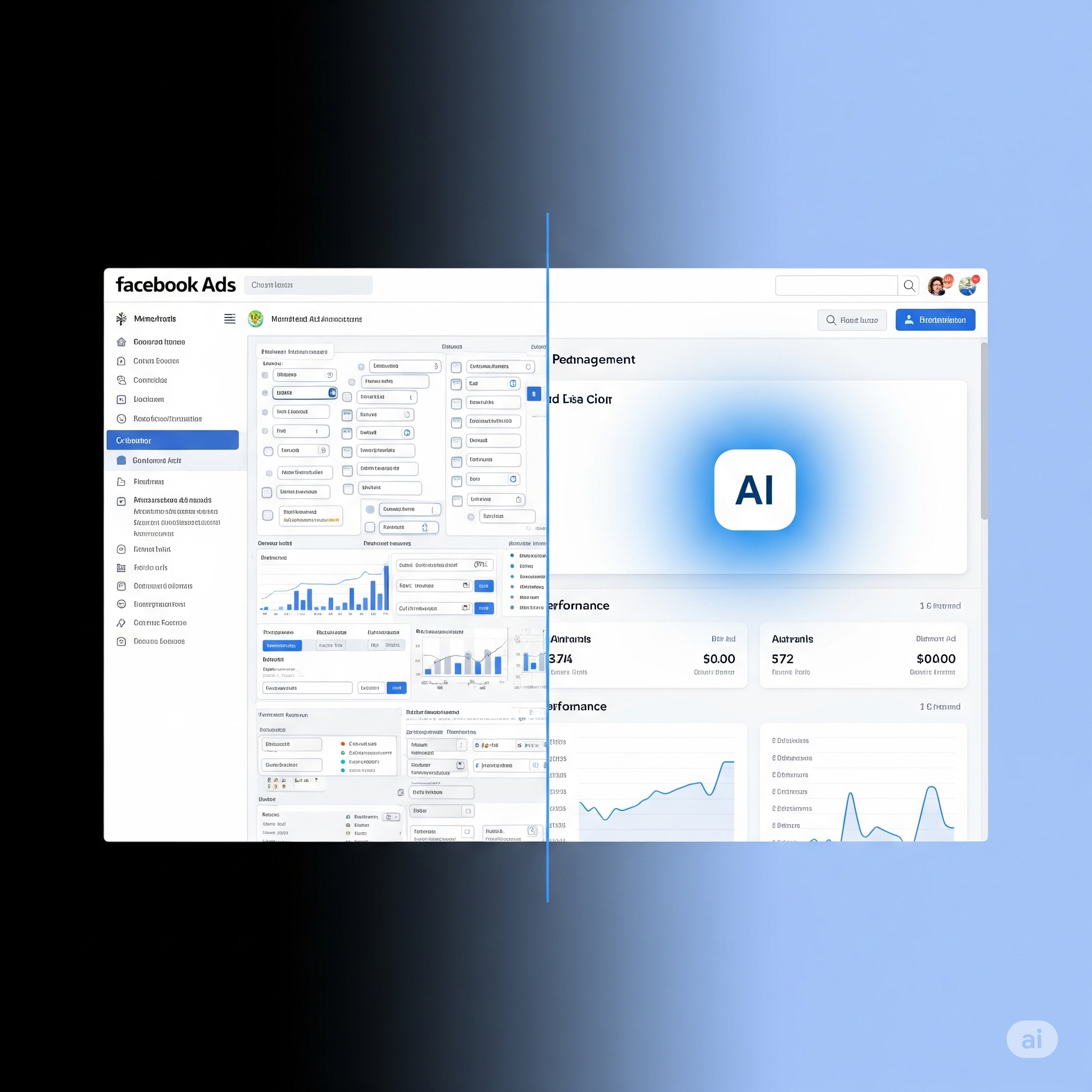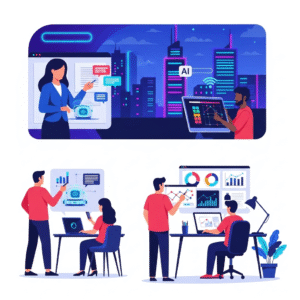I’ve been in the digital marketing trenches for over 15 years. I remember the days of manually split-testing a dozen ad sets, obsessively tweaking bids by the cent, and building intricate audience funnels that looked like a mad scientist’s flowchart. We wore our complexity as a badge of honor. We thought we were master puppeteers, pulling every string. Well, let me tell you, those days are over. If you’re still trying to run Facebook and Instagram ads like it’s 2018, you’re not just behind the curve; you’re bringing a knife to a laser fight. (Meta Ads AI)
The game has fundamentally changed, and the new rulebook is written by one author: Meta Ads AI. This isn’t just another feature or a fancy new button in Ads Manager. It’s a complete paradigm shift in how we approach paid social. For veterans like me, it required unlearning a decade of “best practices.” For newcomers, it’s a massive opportunity to get incredible results without years of manual experience. This is my no-fluff, no-hype guide to what you actually need to know to win with AI on Meta’s platforms in 2025.
What is Meta Ads AI, Really? A No-Fluff Explanation
When we talk about Meta Ads AI, we’re primarily talking about Meta’s suite of automated tools, collectively known as Advantage+. Forget thinking of it as a single entity; it’s an ecosystem of AI-powered features woven into the fabric of the entire campaign creation process. From audience targeting and budget allocation to creative variations and placements, the AI is designed to take over the granular decisions that we humans, frankly, aren’t very good at making at scale.
Its goal is simple: find the most efficient path to your desired outcome (a purchase, a lead, a click) with minimal manual input. The system analyzes trillions of data points—user behaviors, conversion histories, and on-platform engagement signals—that are impossible for any human to process. This is the core of Facebook Ads AI today. It’s about feeding the machine the right objectives and high-quality creative, then letting its powerful algorithm find your customers for you. It’s less about being a puppeteer and more about being a great coach for a superstar athlete.
The Core Components of Meta Ads AI You Must Understand in 2025
To effectively use Meta Ads AI, you need to understand its key components. These are the levers you still have control over, and knowing what they do is crucial for giving the AI the right instructions.
H3: Advantage+ Shopping Campaigns: The E-commerce Powerhouse
This is the crown jewel of Meta Ads AI for any e-commerce business. An Advantage+ Shopping Campaign (ASC) consolidates the entire campaign setup. You provide your pixel data, your product catalog, and your best creative assets (videos, images, copy). The AI then takes full control of targeting (prospecting new customers and retargeting existing ones simultaneously), placements, and creative delivery, dynamically testing combinations to find what works best. It simplifies the account structure immensely and, when fed good data, can be terrifyingly effective at driving sales.
H3: Advantage+ Audience: Letting Go of Manual Targeting
This is the feature that scares old-school marketers the most. With Advantage+ Audience, you provide a few suggestions—your past custom audiences, some interest ideas—as a starting point. The AI uses this as a “hint” but has the freedom to go far beyond your initial inputs to find people likely to convert. It effectively breaks down the walls between your carefully curated audiences, looking for conversion signals across the entire platform. The key here is trusting the process; the AI’s targeting will almost always outperform a hyper-specific, manually selected interest group in the long run.
H3: Advantage+ Creative: Your AI-Powered Design Assistant
You upload your core creative assets, and Advantage+ Creative automatically remixes them. It might turn your image into a video, add music, apply visual filters, or reformat your ad for different placements like Reels or Stories. It also tests different combinations of your headlines, primary text, and descriptions. This feature ensures your ads are always optimized for the placement they appear in and helps combat creative fatigue by constantly generating slight variations. It’s a powerful tool for getting more mileage out of your best creative concepts.
From the Trenches: Real-World Case Studies of Meta Ads AI in Action
Theory is one thing; results are another. Here’s how Meta Ads AI is performing in the wild.
Case Study 1: “Himalayan Threads” – A Rishikesh-Based Apparel Brand
A direct-to-consumer (DTC) fashion brand based here in Rishikesh, specializing in sustainable yoga wear, was struggling to scale beyond its initial customer base. Their ROAS (Return on Ad Spend) was stuck at a breakeven 2.0x using manual interest targeting.
- Problem: Stagnant growth and an inability to profitably acquire new customers at scale.
- AI Solution: They consolidated their complex campaigns into a single Advantage+ Shopping Campaign. They uploaded their top 10 video ads and 10 best lifestyle images, wrote five strong ad copy variations, and set a target cost-per-acquisition (CPA).
- Outcome: After a one-week learning phase, the Meta Ads AI began identifying high-intent buyers well outside their initial targeting (e.g., wellness enthusiasts in European cities they hadn’t considered). Their ROAS climbed to 4.5x, and they were able to double their ad spend while maintaining profitability, leading to a 120% increase in monthly revenue.
Case Study 2: “LeadFlow,” a B2B SaaS Company
A startup offering project management software wanted to generate demo requests. Their lead costs were high because they were trying to pinpoint exact job titles and company sizes, leading to small, expensive audiences.
- Problem: High cost-per-lead and difficulty scaling their lead generation efforts.
- AI Solution: They switched to a lead generation campaign using Advantage+ Audience. They provided their website visitor custom audience and a lookalike audience from their existing customers as suggestions.
- Outcome: The AI quickly learned the characteristics of a high-quality lead and expanded its reach. The cost-per-demo request dropped by 40% in the first month. As a bonus, the AI identified a new, converting audience segment—operations managers in non-tech industries—that the company had never targeted before.
Beyond the Platform: Essential Social Media AI Tools to Complement Meta Ads AI
While Meta Ads AI is powerful, it works best when you feed it great inputs. The AI handles the delivery, but the strategy and creative are still on you. These tools are part of my daily workflow.
- For Ad Copy & Concepting: ChatGPT and Jasper are non-negotiable. Use them to brainstorm creative angles, write dozens of headline variations, and overcome writer’s block. The key is to use them for ideation, not just final copy.
- For Ad Creative: While Meta’s internal tools are good, platforms like Canva have incredible AI features for non-designers. For rapid, AI-driven creative generation, AdCreative.ai can produce hundreds of visual variations for testing.
- For Connecting Your Funnel: Zapier is the essential glue. Use it to instantly send leads from Meta Lead Ads to your CRM or email platform, enabling immediate follow-up, which is critical for conversion.
- For Deep-Dive Analysis: While Ads Manager provides good data, a business intelligence tool like Microsoft Power BI or Tableau allows you to merge your ad data with your sales data to analyze true lifetime value and long-term profitability.
A 15-Year Vet’s Workflow for Launching a Successful Meta Ads AI Campaign
Here’s how I approach a campaign in 2025. It’s simpler and more strategic than the old way.
- Foundation First: Pixel & Conversions API. Your data is the food for the AI. Ensure your Meta Pixel is firing correctly and you have Conversions API set up for the most robust data tracking. Without clean data, the AI is flying blind.
- Focus on Creative & Offer. This is where you, the human, provide the most value. Spend 80% of your time developing compelling creative (especially video) and an irresistible offer. Test different hooks, angles, and value propositions.
- Consolidate Your Account Structure. Resist the urge to create dozens of ad sets. For e-commerce, lean heavily on Advantage+ Shopping. For lead gen or other objectives, use a single campaign with Advantage+ Audience and let the AI find the winners.
- Give the AI Clear Objectives. Choose the campaign objective that matches your business goal. If you want sales, optimize for purchases, not link clicks. Be clear about what you want the AI to do.
- Be Patient & Trust the Process. The AI needs time and data (typically 50 conversions per week) to exit the “learning phase.” Don’t make drastic changes to a campaign in the first few days. Let it run, gather data, and optimize. This requires a level of trust many old-school advertisers struggle with. As a McKinsey report highlights, becoming a data-driven enterprise means trusting the insights the systems provide.
The shift to Meta Ads AI is the most significant change I’ve witnessed in my career. It’s moving us from being manual operators to strategic thinkers. Our job is no longer to micromanage the machine but to provide it with brilliant creative fuel and clear business objectives. Embrace this change, learn to trust the algorithm, and focus your energy on what humans do best: strategy, creativity, and understanding your customer. Do that, and you’ll find more success than you ever could with the old, manual way of doing things.
NLP Tools for Professionals are Transforming Text Analysis with AI



